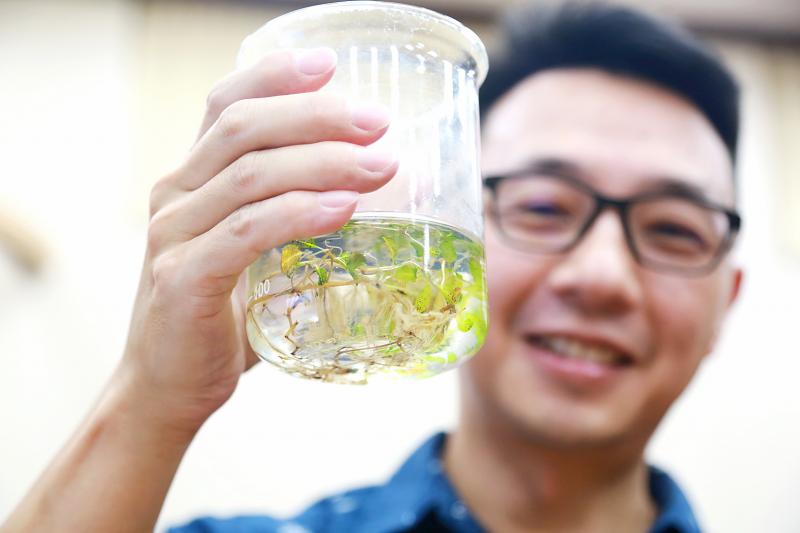Researchers from National Sun Yat-sen University (NSYSU) and the University of Ruhuna in Sri Lanka have identified previously ambiguous types of seagrass, including the world’s first hybridization between two particular species, potentially contributing to conservation efforts for the important carbon fixers.
A study published last month in the journal PeerJ used genetic as well as morphological examination techniques to identify various types of Halophila seagrass, whose features are often difficult to distinguish by sight alone.
“By using only a morphological approach, the genus could be over-split or similar species could be erroneously lumped, thus masking its true biodiversity,” the paper’s abstract says.

Photo: CNA
The study was the world’s first to use molecular identification techniques on seagrass in Sri Lanka, said Vanson Liu (劉商隱), an assistant professor in NSYSU’s Department of Marine Biotechnology and Resources.
NSYSU researchers visited Sri Lanka twice since 2018 to collect samples, discovering one new hybrid species — a cross between H ovalis and H major — and two potentially new species, Liu said yesterday.
The research shows that seagrass diversity in Sri Lanka has been severely underestimated, he said, adding that Taiwan has a similar climate and seagrass diversity.
Seagrass is distributed in most areas around Taiwan, and have been relatively thoroughly researched near the Pratas Islands (Dongsha Islands, 東沙群島) and Penghu County, Liu said.
However, some seagrass meadows are disappearing due to human activity near the shore, leaving only small patches that are often overlooked, he said.
Only 12 species of seagrass have been recorded near Taiwan, although comprehensive, long-term research is lacking, he added.
Seagrass is particularly important for the environment, as they are major carbon sinks, Liu said.
Previous research has shown that every square meter of seagrass near the Pratas Islands is capable of capturing about 1 tonne of carbon each year for a total of 120,000 tonnes annually, he said.
However, seagrass has become less abundant around Taiwan in the past few years, with 2014 in particular seeing a major die out near the Pratas Islands, he added.
As atmospheric carbon continues to rise, Taiwan should monitor the diversity of its seagrass meadows and improve scientific education to convey their importance, Liu said.
The nation should also establish conservation areas to promote seagrass recovery and protect Taiwan’s “blue carbon” sink, he added.

Three batches of banana sauce imported from the Philippines were intercepted at the border after they were found to contain the banned industrial dye Orange G, the Food and Drug Administration (FDA) said yesterday. From today through Sept. 2 next year, all seasoning sauces from the Philippines are to be subject to the FDA’s strictest border inspection, meaning 100 percent testing for illegal dyes before entry is allowed, it said in a statement. Orange G is an industrial coloring agent that is not permitted for food use in Taiwan or internationally, said Cheng Wei-chih (鄭維智), head of the FDA’s Northern Center for

LOOKING NORTH: The base would enhance the military’s awareness of activities in the Bashi Channel, which China Coast Guard ships have been frequenting, an expert said The Philippine Navy on Thursday last week inaugurated a forward operating base in the country’s northern most province of Batanes, which at 185km from Taiwan would be strategically important in a military conflict in the Taiwan Strait. The Philippine Daily Inquirer quoted Northern Luzon Command Commander Lieutenant General Fernyl Buca as saying that the base in Mahatao would bolster the country’s northern defenses and response capabilities. The base is also a response to the “irregular presence this month of armed” of China Coast Guard vessels frequenting the Bashi Channel in the Luzon Strait just south of Taiwan, the paper reported, citing a

UNDER PRESSURE: The report cited numerous events that have happened this year to show increased coercion from China, such as military drills and legal threats The Chinese Communist Party (CCP) aims to reinforce its “one China” principle and the idea that Taiwan belongs to the People’s Republic of China by hosting celebratory events this year for the 80th anniversary of the end of World War II, the “retrocession” of Taiwan and the establishment of the UN, the Mainland Affairs Council (MAC) said in its latest report to the Legislative Yuan. Taking advantage of the significant anniversaries, Chinese officials are attempting to assert China’s sovereignty over Taiwan through interviews with international news media and cross-strait exchange events, the report said. Beijing intends to reinforce its “one China” principle

A total lunar eclipse, an astronomical event often referred to as a “blood moon,” would be visible to sky watchers in Taiwan starting just before midnight on Sunday night, the Taipei Astronomical Museum said. The phenomenon is also called “blood moon” due to the reddish-orange hue it takes on as the Earth passes directly between the sun and the moon, completely blocking direct sunlight from reaching the lunar surface. The only light is refracted by the Earth’s atmosphere, and its red wavelengths are bent toward the moon, illuminating it in a dramatic crimson light. Describing the event as the most important astronomical phenomenon